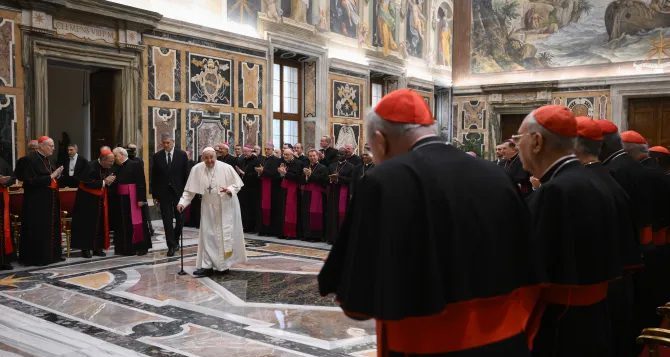For some of us (many of us?), the Lenten resolutions that began back on Ash Wednesday may have fallen by the wayside. Our road to Easter joy might not be as we had planned. Weak wills, self-justified exceptions and exemptions, or life’s legitimate twists and turns may have found us approaching Easter in about the same shape as when we set off.
Oh well, there’s always next year. (Maybe…)
But why wait for what may not happen? Between this Lenten season and the next, there is another chance at Easter glory. In fact, the Easter season—or, better, the Triduum that precedes it—is the perfect time to make a new resolution for a new life. The not-so-hidden secret to this last-minute yet genuine opportunity for renewal is found in the Eucharistic Prayer of the Mass.
Just as the Paschal Triduum of Jesus’ suffering, death, resurrection, and ascension marks the center of the liturgical year, so the Liturgy of the Eucharist forms the heart of the Mass. It is during the Eucharistic Prayers that we ask the Father to “make of us an eternal offering” (Eucharistic Payer III) and, having offered ourselves, to “become a living sacrifice in Christ to the praise of your glory” (Eucharistic Prayer IV). But what do we mean when we pray to become an “eternal offering” and a “living sacrifice”? And why should we want to become these?
“Sacrifice,” Pope Benedict XVI observed, “is a concept that has been buried under the debris of endless misunderstandings” (The Spirit of the Liturgy (San Francisco: Ignatius Press, 2000), p.27). The misunderstood and all-too-common view of “sacrifice” sees it principally as giving up, losing out, or destruction. But how, he goes on to ask, is God satisfied by our suffering pain or loss? Is God somehow more glorified by destruction? Is this why the Father was pleased by what he saw on Calvary—the torture and death of his only beloved Son—and why he opened the gates of paradise to the race that destroyed him? “Obviously not,” Pope Benedict says. “Belonging to God has nothing to do with destruction or non-being” (p.28).
So, if “sacrifice” is not, at its core, destruction (even though sacrifice very well may include pain and loss), what is the true understanding of sacrifice? In a series of remarkable phrases, Benedict proposes that sacrifice is essentially loving union with God. Sacrifice “in its essence is simply returning to love and therefore divinization” (p.33). “The essence of worship, of sacrifice [is] growth in love” (p.33). Sacrifice is “transformation into love” (p.47). Sacrifice “is humanity becoming love with Christ” (p.76). “True ‘sacrifice’ is the civitas Dei, that is, love-transformed mankind, the divinization of creation and the surrender of all things to God: God all in all (cf. 1 Cor 15:28). That is the purpose of the world. That is the essence of sacrifice and worship” (27-8).
I wonder if my Lenten resolutions—and if my progress along the Lenten path—would have been any different had I seen clearly that “sacrifice” and “offering” are, at their core, a loving union with and transformation into God?
But it is precisely this “returning to love,” this “transformation into love” that we pray for, work toward, and should expect when the Liturgy of the Eucharist asks that we become “eternal offerings” and “living sacrifices.” Far from signing up to be perpetually slaughtered and destroyed, we can experience the power of the Eucharistic prayer to change us, even divinize us, if we resolve (such is our Easter resolution) to become one with Christ, in the Spirit, in union with his Father. As St. Paul says (in perhaps Pope Benedict’s favorite quote from scripture): “I urge you therefore, brothers, by the mercies of God, to offer your bodies as a living sacrifice, holy and pleasing to God, your spiritual worship. Do not conform yourselves to this age but be transformed by the renewal of your mind, that you may discern what is the will of God, what is good and pleasing and perfect” (Romans 12:1-2).
It is “this age” that deals in death and destruction, divorced as it is from God. But to “offer our bodies as a living sacrifice” gives true life. If you’ll allow just one last quote from Pope Benedict, the abundant life of one who has made himself, in God, an “eternal offering” and a “living sacrifice” is beyond measure. “‘Eternal life’ is not…life after death, in contrast to this present life, which is transient and not eternal. ‘Eternal life’ is life itself, real life, which can also be lived in the present age and is no longer challenged by physical death. This is the point: to seize ‘life’ here and now, real life that can no longer be destroyed by anything or anyone. …[A] distinguishing feature of the disciple of Jesus is that he ‘lives’: beyond the mere fact of existing, he has found and embraced the real life that everyone is seeking. On the basis of such texts, the early Christians called themselves simply ‘the living’ (hoi zōntes). They had found what all are seeking—life itself, full and, hence, indestructible life” (Jesus of Nazareth: Holy Week (San Francisco: Ignatius Press, 2011), 82-83).
If this is what becoming an eternal offering and a living sacrifice means, let us resolve to do it! The Paschal Mystery of Christ, now present to us in the Eucharistic Prayer, has power (almost) beyond belief. And it is ours for the taking.
Image Source: AB/Wikimedia. Sacrifice of Isaac, by Caravaggio


